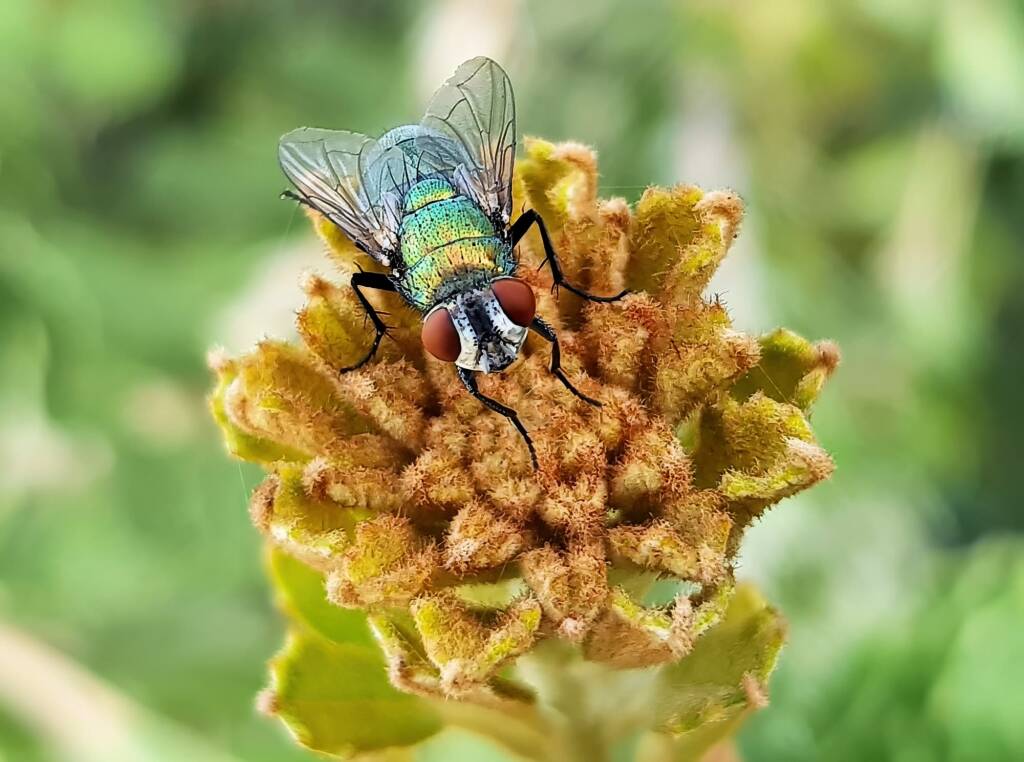DipteraDiptera – image index Flies Pollinators and Flies Australian Sheep Blowfly (Lucilia cuprina) Australian Drain Fly Balaana Beefly Bat Flies Bee Flies Bee Fly (Anthrax) Ligyra Australiphthiria Chrysomya saffranea Eristalinus punctulatus Musca Odontomyia (Soldier Flies) Robber Flies Sarcophaga aurifrons Soldier Fly Syrphids
An introduced pest, the Australian Sheep Blowfly (Lucilia cuprina), formerly named Phaenicia cuprina, is found living in urban areas, semi-arid habitats, forest and woodlands throughout Australia.

The larvae of the Australian Sheep Blowfly feed on carcasses of dead animals, but are also known to cause fly-strike in live sheep. Fly-strike occurs when the female fly lays her eggs in an open wound, or where there is a build-up of faeces or urine in the wool of the sheep. The maggots (the larvae of the Australian Sheep Blowfly) then feed on the living flesh near open wounds.

Lucilia cuprina share many similar characteristics with other species of the family Calliphoridae, such as Lucilia sericata. Both are some of the first blow flies to arrive at a corpse, although unlike L. cuprina, L. sericata does not usually infest live sheep. Whilst L. cuprina is known internationally as a sheep pest, it is usually found in dry climates, unlike L. sericata which tends to have a coastal distribution.

Lucilia cuprina is a species of blow fly characterized by a metallic outer appearance and reddish coloured eyes. They have a shiny green to a greenish/blue abdomen, often with bronze/coppery reflections, which give rise to another common name of bronze bottle flies.
Their body length varies from 4.5–10 mm. They have two pairs of wings, the first pair being membranous wings and the second pair being reduced wings known as halteres (which are used for flight stabilization). The adult flies are easy to distinguish due to bristles on the meron, in addition to the arista, the prominent hair on the terminal antennal segment being plumose, or feathery. L. cuprina is most easily identified by its strong dorsal setae and black thoracic spiracle.

Flies in general also offer benefits as pollinators, especially since different fly species are present all year round. The flies regularly visit flowers for nectar where their hairy bodies pick up pollen.

- Scientific classification
- Kingdom: Animalia
- Phylum: Arthropoda
- Subphylum: Hexapoda
- Class: Insecta
- Informal: Pterygotes
- Order: Diptera
- Suborder: Brachycera
- Infraorder: Cyclorrhapha
- Informal: Schizophora
- Informal: Calyptratae
- Superfamily: Oestroidea
- Family: Calliphoridae
- Subfamily: Luciliinae
- Genus: Lucilia
- Species: Lucilia cuprina
Footnote & References
- Lucilia cuprina (Wiedemann, 1830), Atlas of Living Australia, https://bie.ala.org.au/species/https://biodiversity.org.au/afd/taxa/195bde02-d775-4b20-a434-10466e66e9e1
- Lucilia cuprina, https://en.wikipedia.org/wiki/Lucilia_cuprina (last visited Nov. 30, 2022).
- Australian Sheep Blowfly, Australian Museum, https://australian.museum/learn/animals/insects/australian-sheep-blowfly/
- Blowfly – Family Calliphoridae, Brisbane Insects and Spiders, https://www.brisbaneinsects.com/brisbane_muscoid/Calliphoridae.htm
- Metallic Flies in need of identification, Author Anthony Thomas (Canada), http://www.microscopy-uk.org.uk/mag/artsep11/tt-blowfly.pdf
- Fly Anatomy, Identification Key to the Common Forensically Important Adult Flies (Diptera) of Northern Kentucky, by Regina M. Cutter, Faculty Advisor Dr Greg Dahlem, Department of Biological Sciences, Northern Kentucky University, Highland Heights, KY, https://www.nku.edu/~dahlem/ForensicFlyKey/flyanatomy.htm
- In a document on CSIRO (dated 1950), The Status of the Two Species of Lucilia (DIPTERA, CALLIPHORIDAE) Attacking Sheep in Australia… the summary quotes: L. cuprina is the principal Australian sheep blowfly, whereas L. sericata is comparatively rare in sheep-raising country and does little damage, by D. F. Waterhouse and S. J. Paramonov, June 16, 1950, https://www.publish.csiro.au/bi/pdf/bi9500310
DipteraDiptera – image index Flies Pollinators and Flies Australian Sheep Blowfly (Lucilia cuprina) Australian Drain Fly Balaana Beefly Bat Flies Bee Flies Bee Fly (Anthrax) Ligyra Australiphthiria Chrysomya saffranea Eristalinus punctulatus Musca Odontomyia (Soldier Flies) Robber Flies Sarcophaga aurifrons Soldier Fly Syrphids
InsectsBees Beetles Blattodea Butterflies Coleoptera Cicada Crabronidae Diptera Dragonflies & Damselflies Formicidae Hemiptera Heteroptera (True Bugs) Mango Planthopper Moths Orthoptera Orthopteroid Processionary Caterpillar Stink Bugs, Shield Bugs and Allies Syrphidae Wasps Water Scorpion (Laccotrephes tristis) Witchetty Grub
